|
Emperor Penguins
They brave the Antarctic winters
The world's largest and hardiest
marine birds
If
anyone of you has watched the Oscar award- winning documentary titled
'March of the Penguins,' you will be familiar with the life these
majestic looking feathered beauties live in the Antarctica.
|
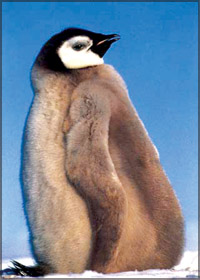
A well-fed chick |
|
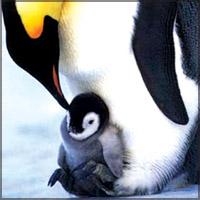
A kiss from mamma |
In case you have not seen the documentary, then don't waste anymore
time - go find it and watch it as soon as possible because it is really
special. Until then, let us enlighten you about the hazardous, but
fascinating lifestyle of these birds.
Emperor penguins are the largest of the 17 species or kinds of
penguins that inhabit the Earth. The second largest are the King
Penguins who also resemble the Emperor penguins in many ways. Reaching a
height of 1.15 m (45.3 inches) and a weight of 20-45 kg (44-99 lbs) the
Emperor penguins are ranked as the fifth heaviest birds in existence.
These birds have black heads and wings, white abdomens, bluish-grey
backs, and purplish-pink bills. They have two golden circular stripes on
the side of the neck. Both males and females have a brood pouch (in the
lower abdomen, between their legs), in which the single egg and the
chick is given warmth and protection from the bitter cold.
If you are wondering why father penguin needs a pouch, here's the
reason. You are definitely going to be totally amazed at the depth of a
father's love, displayed by a creature from the avian world.
Emperor penguins which are endemic (only found or confined in) to
Antarctica are the only penguins to breed in the Antarctic winter. They
are mature enough to breed by the time they reach five years.
|
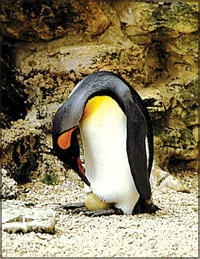
Dadda penguin rolls the egg into the pouch. |
|

“Time to go to the creche baby” |
They follow a routine lifestyle year in and year out, travelling
between feeding grounds and nesting or breeding grounds. They travel 90
km (56 miles) or so inland from the open sea (feeding grounds) to the
breeding site around March-April in temperatures as low as 40 degrees
Celsius.
The long walk is arduous (hard/strenuous) and once they reach the
breeding grounds, the males go into courtship. After a mate is found,
they stay faithful to each other the entire year. Even when they return
for breeding the following year, the couples try to locate the old
mates, but as the colonies are large, they generally cannot find each
other. Then they select new partners.
Father penguin and mother penguin are both caring parents, and do
everything possible to protect their young. When the mother lays a
single, 40 grm egg in May/June after a gestation period of 63 days, the
father penguin has a big role to play.
By the time the female bird is ready to lay her single, precious egg,
the food reserves in her body are virtually exhausted (almost over or
used up). She has no energy to even hatch the egg because she needs to
return to the sea to feed and build up her strength.
So, what do you think happens? Father penguin literally steps in
because the egg is transferred from the mother's brooding pouch to that
of the father's by placing it on the feet first. As the ground is
extremely cold and the egg will freeze if it touches the ground for
long, the transferring has to be done really carefully.
Most adult birds with experience, manage to do this without
endangering the egg, but some of the first timers make a mess of the
whole operation by being either impatient or clumsy.
|
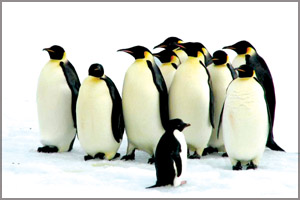
Getting ready to go back to sea... |
|
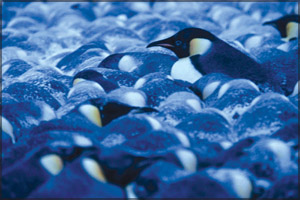
Male bird in ‘turtle formation’ |
The male and the female have to get as close as possible to each
other's webbed feet so that the mamma penguin can roll the egg from
inside her brood pouch to dadda penguin's feet.
It is important to ensure that the egg does not touch the ground and
stay exposed for long. The male or dadda penguin has to then quickly
roll in the egg under his abdomen and cover it with his pouch to keep it
warm and safe.
The egg has to be incubated for 65 days for the chick to be born. And
poor dadda penguine has to ensure it stays safe within his pouch all
that time. Getting about with an egg inside the pouch is out of the
question, so the male penguin spends most of his time sleeping, to
conserve energy. He cannot go anywhere.
Then how does he manage all this time without food? By surviving on
the fat reserves he has built up, eating during the summer.What is hard
is protecting the egg, not only from the cold, but also from other males
(especially young ones) who try to steal the egg because their eggs have
frozen!
The daddas also have a hard time keeping the egg within the pouch,
especially when they are in a great big huddle, warding off the cold.
They have to brave icy rain, cruel winds (200 km per hour) and blinding
snow storms, eating nothing while mama penguins build up their energy,
eating in the cold sea.
How do the males manage to stay warm? By clumping together in a large
group with their backs to the wind to conserve body heat. The defence
tactic they adopt against the cold - standing in a compact huddle, is
known as the 'turtle formation' and ranges in size between five hundred
to 25,000 pairs of birds, each leaning forward on a neighbour.
The birds on the outside of the formation usually shuffle around the
edge, producing a slow churning action. This gives the birds on the
outside a turn in the warm centre. It is during this shuttling that many
lose their eggs, so the daddas have to be extremely careful when moving;
if the eggs fall, they would be destroyed.
In the event the chick hatches before the mother returns, the father
sets it on his feet and covers it with his brood patch; because if it
falls, it would freeze to death. As the chick is hungry and needs food
the dadda bird feeds it with a whitish, milky substance produced by a
gland in the esophagus(passage from the mouth to the stomach). By this
time, the dadda is exhausted; he has lost a third of his body weight. He
is now hungry and tired too.
When it's time for the mothers to return from feeding after about two
months, the father and baby waits impatiently. They recognise each other
via the calls they make and happily get together. Of course the mamas,
whose chicks have not survived, are utterly disappointed and sad.
Once the mammas take over, the dadda penguins have to make a long,
long journey back to the sea to feed, even though they are very tired
and weak. However, since the ice has melted by now the journey to the
open sea is not as long as the one made by the mammas.
The females who now take over the task of looking after the chicks,
do so by keeping them inside the brood pouch. They feed them by
regurgating (bringing up the food stored in their stomachs to the
mouth). Once the males return from feeding in the open sea, both parents
share the responsibility of bringing up 'baby'.
After being sheltered in the mother's pouch for two months, they are
put into a 'creche' where the chicks, huddle together for warmth. They
are fed by the parents until it is summer and time to go to the open sea
to feed.
The entire summer, penguins both young and old spend their time
feeding and building up their energy. Their main diet is crustaceans
(sea creatures with hard shells) such as kril. They also eat squid and
fish.
They dive to depths of 150-250 metres and even deeper in search of
food. They dive at speeds of 6/9 km per hour and stay underwater for
about 15-20 minutes. On land, Emperor penguins walk with a wobbling gait
and slide over the ice on their bellies, propelled by the feet and
flipper-like wings.
Emperor penguins are indeed fascinating creatures and need to be
protected. So, find out more about these wonderful birds and learn to
respect the feathered friends. Watch the documentary as soon as
possible!
***
Fact File
* They live in 24 hours of darkness in the depths of the Antarctic.
* Emperor penguin chicks recognise their parents by their call.
* They are considered to be fully grown in six months.
* The large amounts of body oil help the penguins to stay dry.
* The downy feathers trap air - keeps body temperature in and cold
air and water out.
* Emperor penguins along with nine other species of penguins are
being considered as endangered.
* Climate change, reduction of food sources, habitat destruction, and
the disturbance of breeding grounds by humans are all contributory
factors to their decline.
* The estimated population of Emperor penguins is 250,000 pairs
distributed in as many as 40 independent Antarctic colonies.
* Emperor penguins are social animals because they forage and nest in
groups. They also huddle together for warmth and protection.
* They are active both day and night.
* Males and females almost look alike, but can be distinguished by
the call.
* Their predators are the Antarctic giant petrels, skua, leopard
seals and orcas.
* Emperor penguins have short wedge-shaped tails, shiny waterproof
feathers, tiny flipper-like wings, big heads and short, thick necks.
Their shape help them to survive the harsh Antarctic winters.
* Average lifespan is about 20 years. |
